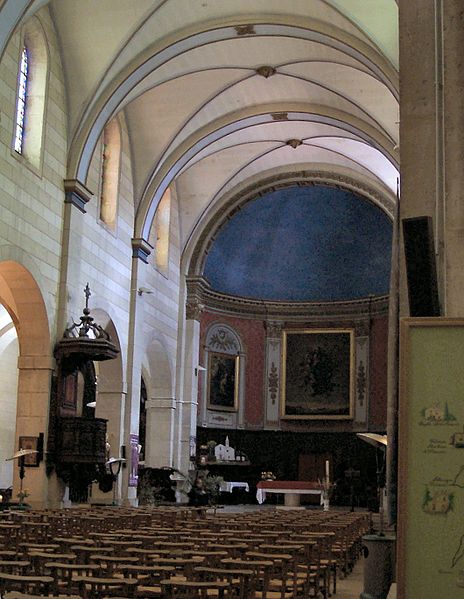St. Maximus, Bishop of Riez, Confessor
About the Year 460.
 ST. MAXIMUS was born in Provence at Decomer, now called Chateau-Redon, near Digne. His truly Christian parents saw him baptized in his infancy, and brought him up in the love and practice of virtue, and an enemy to its bane, the pleasure of the senses, which the saint from his childhood made it his study to subdue and often mortify, so that in his youth he was an excellent example of profound humility, and an absolute conquest of his passions; and his virtue increased with his years. He was well made, and by the sweetness of his temper, and the overflowings of a generous heart, engaged the esteem of all who knew him; but was aware of the dangerous snare of being betrayed into a love of company and the world; and, leading a very retired life in his father’s house, gave himself up to prayer, reading, and serious studies, in which he gave early displays of genius. His mind and heart were so engaged by heavenly things that he trampled on all worldly advantages, and made a resolution of observing a perpetual continence.
ST. MAXIMUS was born in Provence at Decomer, now called Chateau-Redon, near Digne. His truly Christian parents saw him baptized in his infancy, and brought him up in the love and practice of virtue, and an enemy to its bane, the pleasure of the senses, which the saint from his childhood made it his study to subdue and often mortify, so that in his youth he was an excellent example of profound humility, and an absolute conquest of his passions; and his virtue increased with his years. He was well made, and by the sweetness of his temper, and the overflowings of a generous heart, engaged the esteem of all who knew him; but was aware of the dangerous snare of being betrayed into a love of company and the world; and, leading a very retired life in his father’s house, gave himself up to prayer, reading, and serious studies, in which he gave early displays of genius. His mind and heart were so engaged by heavenly things that he trampled on all worldly advantages, and made a resolution of observing a perpetual continence.
Thus he remained some years in the world without living by its maxims, or seeming to belong to it; and, though among his friends, and in his own country, had no more relish for his situation than if he had been in exile, and surrounded by strangers. At last he broke the chain which seemed to fix him to the world, and, distributing his fortune among the poor, retired to the monastery of Lerins, where he was kindly received by St. Honoratus. When that holy founder was made archbishop of Arles, in 426, Maximus was chosen the second abbot of Lerins.
St. Sidonius assures us [1] that the monastery of Lerins seemed to acquire a new lustre by his prudent conduct and bright example, under which the monks scarcely felt the severities of the rule, so great was the cheerfulness and alacrity with which they obeyed him. The gift of miracles with which he was favoured, and the great reputation of his sanctity drew great crowds to his monastery from the continent, which, breaking in upon his retirement, obliged him to quit the house, and conceal himself some days in a forest in the island: though we are assured that the chief reason why he thus lay hid in a very rainy season was, that the clergy and people of Frejus had demanded him for bishop. After this danger was over he again made his appearance at Lerins.

Church and monastery of the Lérins Abbey, on the island of Saint-Honorat, one of the Lérins Islands, close to Cannes, France. Photo by Afernand74
It happened, however, not long after, when he had governed the abbey of Lerins about seven years, that the see of Riez in Provence became vacant about the year 433, and he was compelled to fill it: for though he had fled to the coast of Italy to shun that dignity, he was pursued and brought back. His parents being originally of that city, the saint was looked upon there as a citizen, and, on account of his sanctity, received as an angel from heaven. [2] In this dignity he continued to wear his hair shirt and habit, and to observe the monastic rule as far as was compatible with his functions: he still retained the same love of poverty, the same spirit of penance and prayer, the same indifference to the world, and the same humility, for which he had been so conspicuous in the cloister. But his patience and his charity found more employment, he being by his office the physician, pastor, and teacher, of a numerous people, and charged with the conduct of their souls to lead them to eternal life.
Among the sermons which pass under the name of Eusebius Emisenus, three or four are ascribed to St. Maximus, [3] and the first among those of Faustus of Riez. [4] He assisted at the council of Riez in 439, the first of Orange in 441, that of Arles in 454, and died on the 27th of November before the year 462. His body lies now in the cathedral of Riez, which bears jointly the names of the Blessed Virgin and St. Maximus. [5]
_____________________
See his life written by Dynamius, a patrician in Gaul, some time governor of Provence, and receiver of the rents of the Roman see in Gaul, as appears from St. Greg. l. 3, ep. 33. This work he dedicated to Umbricus, Faustus’s successor in the see of Riez, who died a hermit in 601. See Tillemont, t. 15; Fabricius, Bibl. Mediæ et infimæ Latinit. l. 5, vol. 2, p. 209; Rivet, Hist. Littér. t. 2, p. 357. See also the homily of this saint’s successor. Faustus, bishop of Riez, in his eulogium, published in Latin and French by Dom d’Attichi, in 1644.
Note 1. Carm. 6. v. 113.
Note 2. Faustus of Riez succeeded St. Maximus first in the abbacy of Lerins, afterwards in the episcopacy of Riez, and died about the year 493. His name and works are well known for his vigorous defence of Semipelagianism, which was not condemned by any definition of the church before the second council of Orleans, in 529. See his life in Ceillier, t. 14, p. 157–189; and principally in Rivet, Hist. Lit. t. 2, p. 585–619.
Note 3. Cave, Hist. Liter, t. 1, p. 422.
Note 4. Rivet, Hist. Littér. t. 2, p. 360.
Note 5. St. Maximus, patron of the diocess of Boulogne in Picardy, is called Masse by the common people at Boulogne, and Mans at Abbeville in Picardy. In the diocesses of Boulogne, St. Omer, and Ypres, he is singularly honoured, but confounded by mistake with St. Maximus of Riez.
(cfr. The Lives of the Saints, by Rev. Alban Butler (1711–73). Volume XI: November, pp. 569-570)










